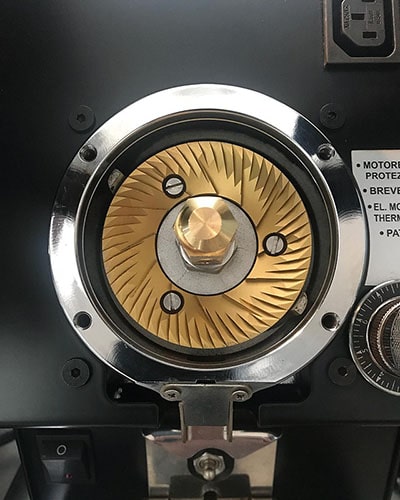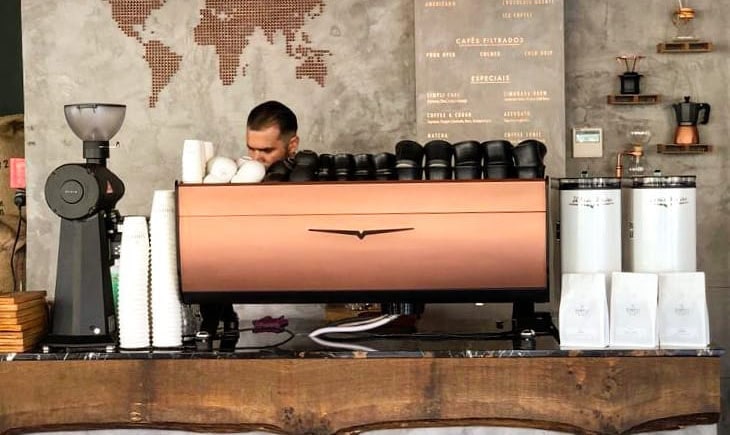In a coffee shop setup, it’s usually the espresso machine that gets all the attention. The machine is the big brand name that brings in customers, the flashy piece of design that defines the look of your bar — and the biggest purchase.
But choosing the right espresso grinder is at least as important as choosing the right espresso machine — maybe even more so.
we explained before what to look for in an espresso machine, and gave a rundown on the best five espresso machines for your coffee shop. Now it’s time to consider the grinder, and give this vital piece of equipment the full attention it deserves.
Why is the grinder so important?
The quality of the grinder has a big effect on the flavor of the final espresso — perhaps even more than the quality of the espresso machine.
Better grinders break beans into more evenly-sized pieces, which helps the coffee to extract more evenly. This aspect of a grinder’s quality is hard to quantify, but the best grinders develop a reputation among baristas for consistently making delicious espresso.
The design of the grinder also has a critical influence on the barista’s workflow and speed. The better the grinder, the less time the barista has to spend weighing the coffee and tweaking the grind size.
A good grinder can help a barista work more quickly. The best grinders also reduce waste, making it less likely for a barista to need to dump shots in the sink, or throw ground coffee in the bin.
The grinder determines how many coffees you can make in a day and still maintain good drink quality.
In many cases, the choice of grinder has a bigger effect on your maximum capacity than the choice of espresso machine. Many modern espresso machines can keep up with even the fastest barista — while even the best grinders heat up during use, which quickly starts to affect the drink quality.
Grinding on demand
A specialty coffee shop should only ever consider ‘on-demand’ grinders — they keep coffee fresh, and save a lot of wasted coffee.
Traditional espresso grinders have a chamber on the front called a ‘doser’. The coffee is ground ahead of time, and sits in the doser until needed, losing aroma and going stale the whole time. An on-demand grinder only grinds the coffee when it is needed, for fresher, tastier coffee.
The very best grinder designs take this even further, by minimizing the amount of ground coffee that sits inside the grinder between shots (called ‘retention’). Low retention means that the coffee the grinder delivers is even fresher, but more importantly it reduces wastage.
When a barista changes the grind size, they need to get rid of all the ground coffee that was already sitting in the grinder before they can start using the coffee with the new grind size. Some grinder designs can hold as much as 40 grams of ground coffee, which should be thrown away every time the barista makes a change. The best designs, however, reduce that amount to just a few grams.
A low retention grinder will make your baristas faster, your coffee fresher, and will reduce waste — paying for itself many times over.
What makes a good grinder?
قد لا تتضح الخصائص الهامة في المطحنة الجيدة والتي تصنع فارقاً في أداء الباريستا بسهولة من الوهلة الأولى.
The features of a grinder that really make a difference to baristas aren’t always easy to spot at first glance.
One of the most important factors in the quality of a grinder is the size of the burrs. Larger burrs have more cutting area, so they grind more quickly, and can grind more coffee without heating up too much. They also tend to produce more even grind sizes and better flavor in the cup. Bigger is not always better, however, as the design and material of the burrs also plays a part.
It’s also important to consider how the grinder will affect your workflow.
- How easy is it to adjust the grind size, or reprogram the settings?
- Do you have to hold the portafilter in place while it grinds, or are you free to do other things while you wait?
- Does the grinder distribute the coffee evenly into the filter basket, or do you have to spend a lot of time spreading the grounds around?Does the grinder distribute the coffee evenly into the filter basket, or do you have to spend a lot of time spreading the grounds around?
On the other hand, the grinder’s speed is, surprisingly, not all that important. A few seconds’ difference in the time taken to grind a dose does not affect the barista’s workflow that much. There is also some evidence that running a grinder at higher speeds can make for worse grind quality.
For high-volume locations, some sort of cooling is essential. Grinders heat up during use, and the heat affects the way the coffee grinds. This is the main reason that baristas need to constantly adjust the grind size during the day.
If the grinder is more temperature-stable, then the barista can spend less time fiddling with the grinder and more time making coffee.
If the grinder is more temperature-stable, then the barista can spend less time fiddling with the grinder and more time making coffee.
The last factor to consider is how easy it is to take the grinder apart and clean it. Regular cleaning will greatly improve the flavor of your espresso. Some grinders are specifically designed to be easy to disassemble, which makes your baristas’ lives much easier.
How many grinders do you need?
 Photo description (Source)
Photo description (Source)
Many new cafe owners are dismayed to discover that they might need to buy more than one grinder.
Espresso grinders are highly specialized, and in most cases can only be used to make espresso, and can only handle one kind of bean at a time. This means that if you want to make filter coffee, you need a separate grinder; if you want to serve decaf, you need yet another grinder; and if you want to offer your guests a range of different single origin espressos to try, you need a different grinder for each one.
 Photo description (Source)
Photo description (Source)
The good news is that not all of those grinders need to be top of the line. If you only serve a handful of decaf coffees per day, then you can use a much smaller grinder for this. Similarly, for single origin espressos it may make sense to choose a grinder that makes great quality drinks, but has a lower capacity. This can reduce your overall budget, and in the next chapter we’ll help you find the best grinders on a tight budget.
Alternatively, to avoid having a bank of grinders taking up space on the bar — and leaving a hole in your budget — it’s worth considering a single-dosing grinder, such as the EK43. In a single dosing grinder, instead of keeping the hopper full of beans, the barista puts one dose at a time into the grinder when needed.
A single-dosing grinder allows the barista to use a single grinder to make many different kinds of coffee — potentially covering filter coffee, decaf, and a whole range of single origin espressos with just one grinder.
The disadvantage is that using single-dosing grinders takes a little bit more time and effort than working with grinders designed for espresso. The barista has to weigh out the beans in advance, throw them in the hopper, grind the coffee, pour the grounds into the portafilter, and then weigh the coffee again. For this reason, we only recommend using this method for coffees that get ordered less often. Single-dosing grinders are perfect for decaf and rare single origin espressos, but slow the barista down too much to use for the main espresso blend.
For most cafes, therefore, the ideal setup is one dedicated espresso grinder, and one single-dosing grinder — with perhaps a smaller, dedicated espresso grinder for decaf, if you expect your customers to order it frequently.
اختيار المطحنة الصحيحة للمقهى الخاص بك لا يقل أهمية عن اختيار آلة الإسبريسو الصحيحة. معرفة أهم ما يجب النظر إليه عند اختيار المطحنة هو نصف المهمة، ولكننا سنوضح في فصلٍ لاحق كيفية اختيار المطحنة الصحيحة المناسبة لعملك التجاري.
Choosing the right grinders for your cafe can be just as important as choosing the right espresso machine. Knowing what to look for in a good grinder is half the battle — but in the next article, we will help you find the right grinder for your business.
Still searching for The One?
Contact our team for a free personalized consultation,
and we will help you find what you’re looking for.



